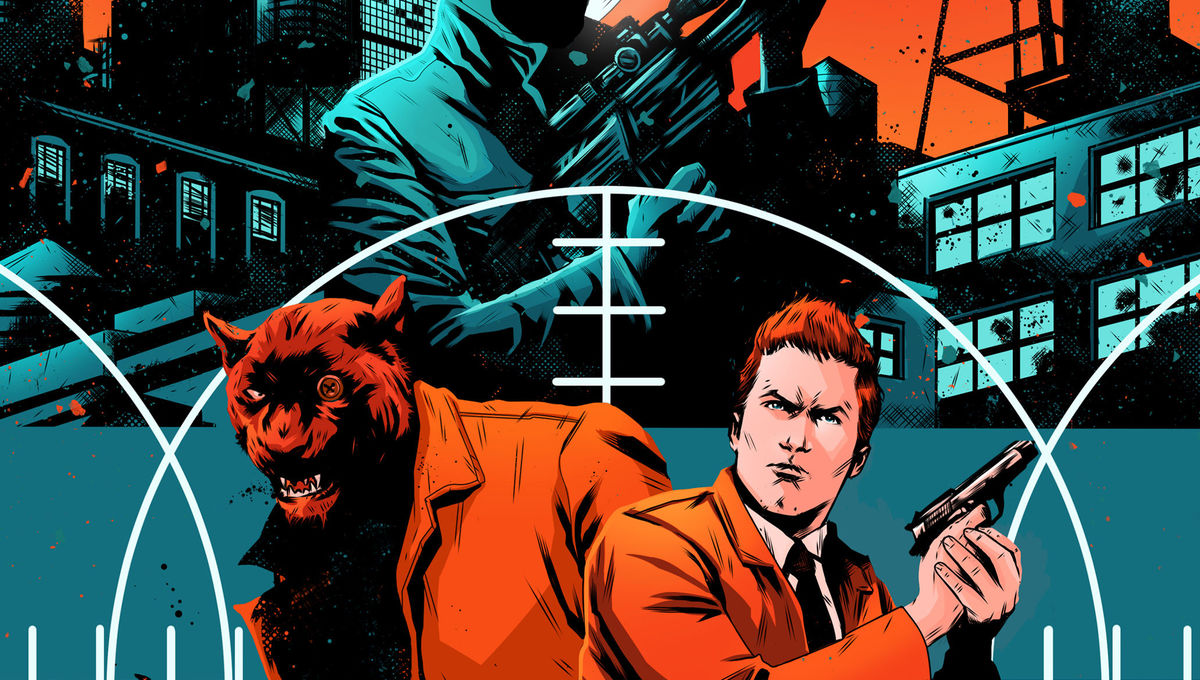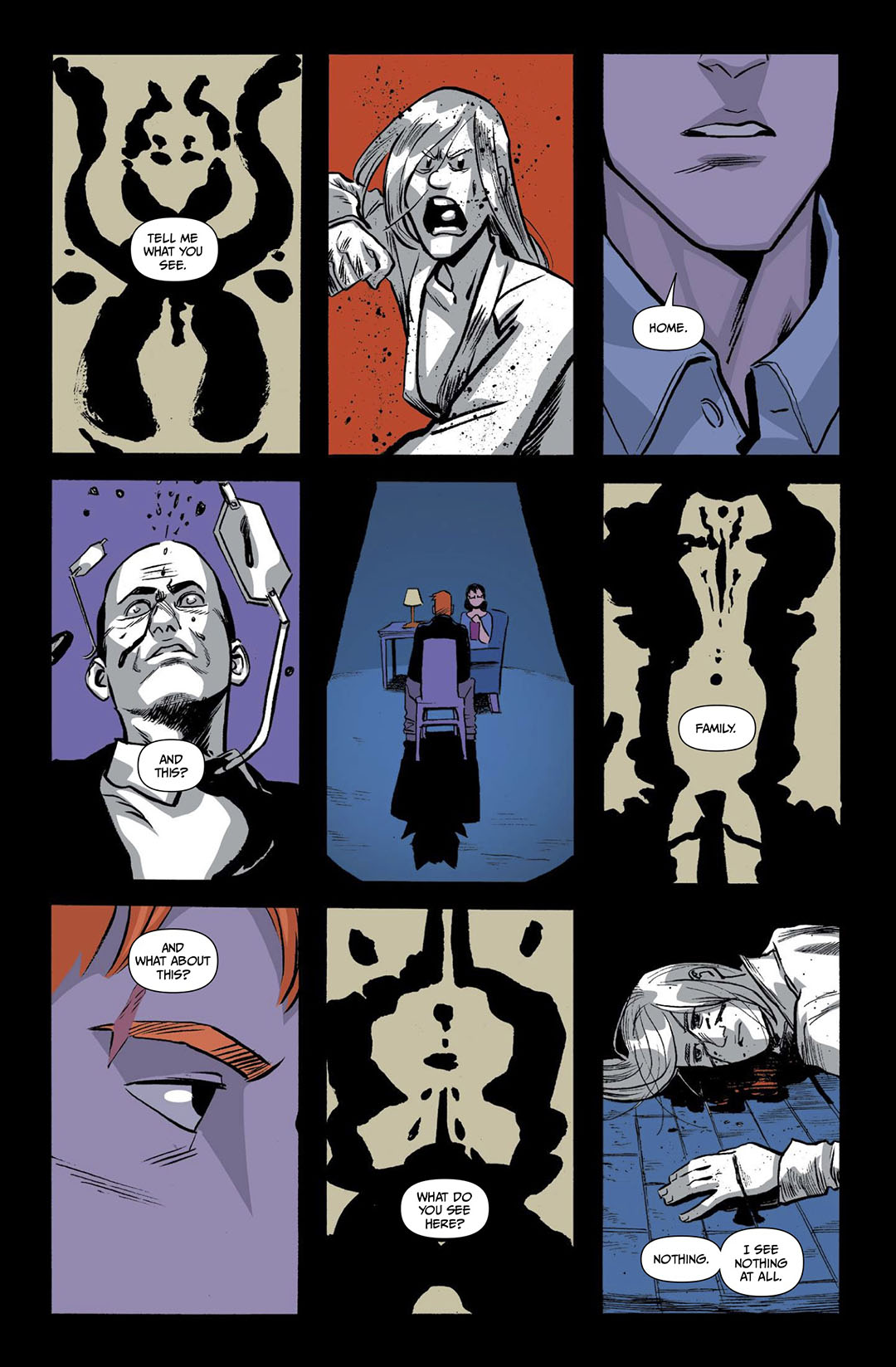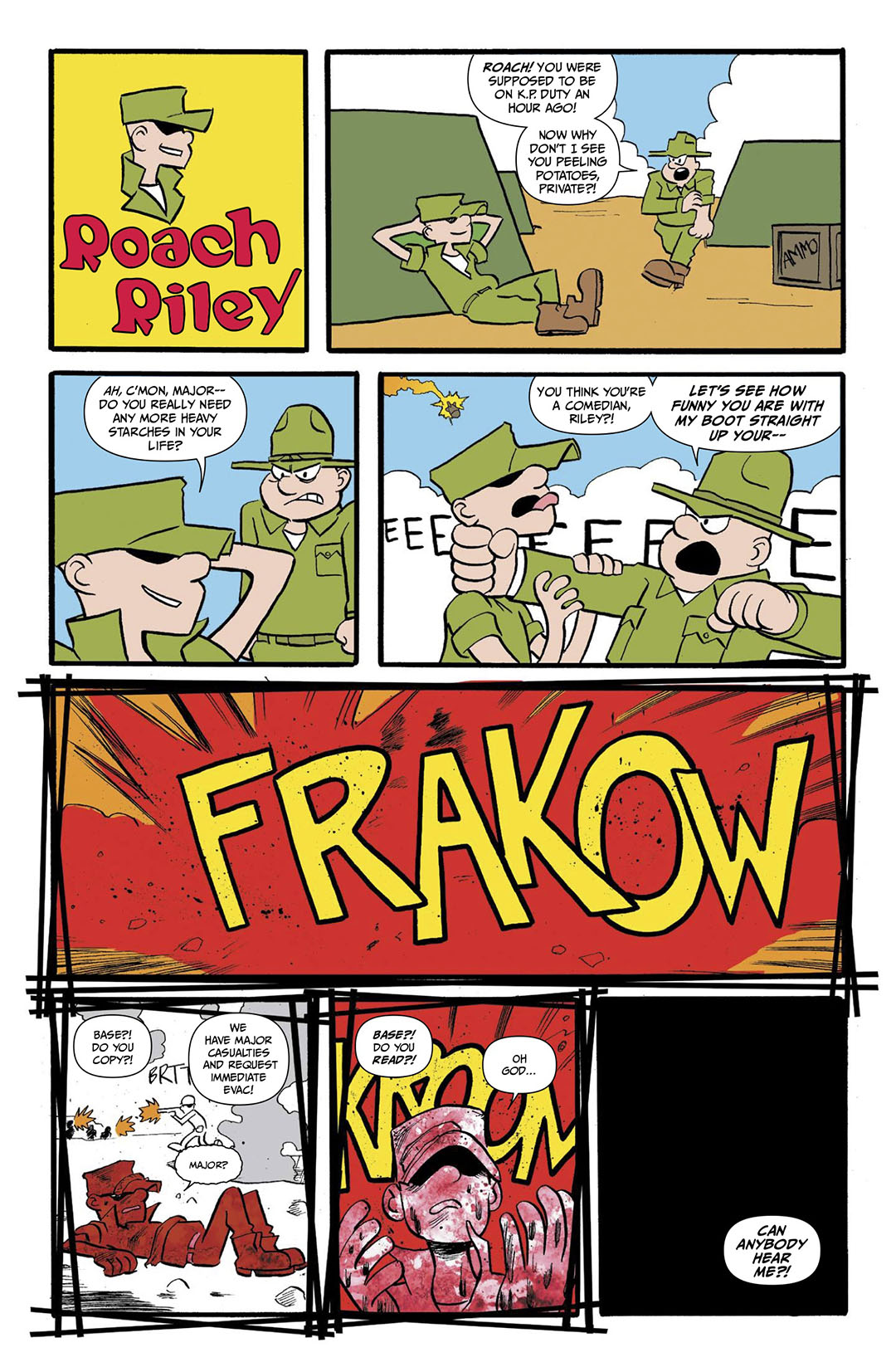
Spencer & Locke 2
Writer: David Pepose
Artist: Jorge Santiago Jr.
Publisher: Action Labs Comics
Hits the shelves: April 24, 2019
An interview by Josh Rose and Stephanie Pouliotte
 Suspended by Internal Affairs, Detective Locke grapples with the demons of his past alongside his trusty partner, his childhood imaginary panther Spencer. But when Spencer and Locke face a scarred soldier named Roach Riley, will this unlikely pair finally meet their match?
Suspended by Internal Affairs, Detective Locke grapples with the demons of his past alongside his trusty partner, his childhood imaginary panther Spencer. But when Spencer and Locke face a scarred soldier named Roach Riley, will this unlikely pair finally meet their match?
Rogues Portal: Spencer & Locke really took off, were you both surprised at the reception and did it push you to do a second volume, or did you always plan for more in this series?
David Pepose: You know, you always hope that people will respond to your work, but the reception to the original Spencer & Locke really went above and beyond anything we could have expected. Especially with a high concept like ours, you never know how people are going to respond — because when your elevator pitch is “what if Calvin and Hobbes grew up in Sin City,” you’re going to get a pretty strong reaction one way or the other — but our readers really got what we were doing, and thankfully they were incredibly vocal about it.
Which brings me to the cool part — that we’re taking Spencer and Locke 2 across the funny pages! The idea of expanding our high concept from just spoofing Calvin and Hobbes to taking a Fables-style approach just felt like a natural progression, especially given the remix sensibilities Jorge and I brought to the first series. It’s easy to rest on our laurels, but we wanted to make sure we justified any sequel to the original Spencer & Locke beyond a shadow of a doubt — we know readers have a lot of comics to choose from, so we had to evolve or die.
Jorge Santiago Jr.: I honestly had no idea people would enjoy Spencer & Locke as much as they did. My goal was mainly to make the best comic that I could, so it was surprising to see people really latching on to this pair and finding real empathy for them. I knew David had plans for more, but my interest in doing more was based on what story we could tell with a sequel. A lot of stories get hard to justify sequels or ones that are tacked on for the sake of money, but I think Spencer & Locke 2 adds to the story in a meaningful way, so I wanted to come back for that.
RP: Calvin and Hobbes is a humorous comic but it delves into serious themes on occasion (the racoon incident, when Hobbes was lost), and those strips certainly have a unique emotional impact in part due to the shift in tone. What does re imagining these classic strips in such a dark, gruesome world allow you explore?
David Pepose: What’s funny about Spencer & Locke , at least to me, is that we’re essentially homaging Watterson’s work but taking almost the exact opposite angle — by following a hard-boiled cop and his imaginary talking panther, we’re able to tackle some really dark and painful themes in search of catharsis, but we’re able to use humor and the sheer weirdness of our core concept as a sort of an escape valve to release that pressure as needed.
But ultimately, I’ve found that exploring Spencer and Locke’s unresolved pain and trauma to be really inspiring — because I think that’s a universal theme for so many people. Everyone has been hurt at some point in our lives — but are we defined by our scars? Or like Locke conjuring Spencer as the ultimate defense mechanism, can we channel our pain into something better? And with Spencer & Locke 2, we’re able to examine even more perspectives on our inner demons, and how they shape our past and drive our actions into the future.
Jorge Santiago Jr.: For me, I find the psychology of Spencer & Locke to be the most interesting aspect of our shift to a darker tone over C&H. For Calvin, Hobbes is a product of his overactive imagination but also represents his practical side; for Locke, Spencer is his protector, generated from an abused child’s desire to have someone save him from the hell he grew up in. The fact that Locke has this need for Spencer even after reaching adulthood and the events of volume 1, shows a lot about the structure of his psyche and also some other problems that Spencer could end up being the harbinger of.

RP: Why make a comic inspired by classic cartoon strips in the first place?
David Pepose: People say write about what you know, right? But when I first toyed with the idea of taking the leap to write a comic of my own, that advice just felt paralyzing. What did I know about literally anything? The only thing I could think that I knew was comics… but then I realized that maybe that knowledge base wasn’t as limiting as I might have thought.
The idea of mashing up two of comics’ greatest artistic visionaries — namely, Bill Watterson and Frank Miller — felt like the sort of thing that I’d want to see as a comic fan. If nothing else, just to see if the idiots involved could possibly pull it off, or totally crash and burn trying. (Laughs) It’s the sort of concept that appeals to me as a process junkie and a comics history nerd, and it only became more exciting for me once you started adding in the psychological elements.
Jorge Santiago Jr.: In order to be a good writer, I think you have to study everything for its pros and its cons, and sometimes the clues to breaking new ground in story is to take something that exists and turn it on its head or add in a new element. A lot of stories that I’ve written are born in that process, such as my webcomic CURSE OF THE EEL, which is my subversion of both horror movies and Lovecraftian lore to make something that is suited to my tastes. I know some people are sore with the idea of taking a comic from their childhood and finding an inspiration in changing that, but I think with Spencer & Locke , the story isn’t close to Calvin & Hobbes anymore. The kindling is there, but the fire is totally different, but that’s the fun of storytelling; it’s all about passing the torch of story.
RP: How did you decide on which comics to parody and which of their strips to feature? Did you have the idea for what kind of story you wanted to tell and subsequently found the strip, or did you choose the strip first and went from there?
David Pepose: It’s a little bit of Column A, a little bit of Column B — for Spencer and Locke’s storylines in particular, any big sequences I usually cross-referenced against the original Bill Watterson strips, to see what touchstones people might expect and what we could organically fit into the story. But as far as those two’s flashbacks would go, I took the opposite approach — I’d usually write a flashback to match the mood of the surrounding present-day scene, which would let me check off smaller-scale elements of Calvin and Hobbes that we hadn’t been able to parody previously.
But with Spencer & Locke 2, we’re also incorporating so many more comic strips into the mix, and a lot of that was based on my own experience reading the funny pages as a kid in the St. Louis Post-Dispatch. I was lucky enough that my hometown paper had a really robust comics section, and so I really wanted to include as many of those strips in particular, including Beetle Bailey, Brenda Starr and Hi & Lois. So much of Spencer & Locke is about reexamining childhood, so it felt right to incorporate my own, in some small way.
RP: In Spencer and Locke 2, you’re introducing a new comic into the mix with Roach Riley. Did this bring along challenges in pacing or logistically on the page?
David Pepose: Yeah, since I had gotten comfortable writing Spencer and Locke’s headspaces, of course we had to shake things up by throwing a new challenger in the mix! (Laughs) So there were a few challenges incorporating a character like Roach into this series. Like you mentioned, we had to be really careful with our pacing, to make sure that we gave Roach enough real estate to be a credible threat, while not giving short shrift to Spencer and Locke themselves.
But for me, the biggest challenge was characterization. The real appeal of Spencer and Locke as characters was that they felt three-dimensional and organic, with their own perspectives, opinions, senses of humor, and points of view. So I wanted to make sure that Roach, as our new villain, was just as exciting and fully realized as our protagonists. It’s by design that instead of opening up each issue with a Calvin and Hobbes-style flashback, we’re riffing on Beetle Bailey instead — you’ll find that Spencer & Locke 2 is just as much Roach’s story as it is Locke’s.
Jorge Santiago Jr.: I don’t think it was any more difficult than how we did it in volume one because we knew why we were doing the art changes so it just made sense. In the movie Memento, Christopher Nolan differentiates Leonard Shelby’s differing memories by the use of color or black and white film; the scenes going forward in time are in B&W while the scenes going backwards are in color. Our approach for the art integrations is similar, except now we’ve added another variable, but the technique is the same. The structure of comics is probably my favorite part, and using visual cues to denote changes in time, mood, and story without the use of heavy context captions (like “20 years ago, the home where Locke grew up) is the strongest arrow in our quiver.

RP: Why Beetle Bailey and not another strip like Blondie or Peanuts? Are there other strips you are thinking of using in the future?
David Pepose: When I was thinking of additional arcs to this series, I thought a lot about the kinds of threats that police officers face — and while people often think of street crime and drug cartels, the idea of large-scale terrorism really felt like the perfect way to escalate our series in terms of scale and stakes. So with that trajectory in mind, Beetle Bailey really was the most natural choice for us to parody for Volume 2. Part of that is because the idea of a murderous Beetle Bailey is the sort of concept that might draw the same surprised laugh as hard-boiled, schizophrenic Calvin and Hobbes — people are immediately going to wonder how these characters have made that leap, not to mention whether or not we’ll stick the landing.
But the beauty of our sequel’s high concept is that while Spencer, Locke, and Roach are our headliners, we’ve got room for supporting characters and cameos from across the funny pages. It’s funny you mention Blondie, because she almost made the cut — a lot of the decision-making was deciding what was organic to Spencer and Locke’s ongoing story, and what would be recognizable in terms of concept and design. And as for Peanuts — well, that’s the kind of strip you want to build up to first! (Laughs) Maybe if Volume 2 works out — I will say we’ve got a very quick nod to a certain five-cent psychiatrist in our first issue, however…
Jorge Santiago Jr.: I feel like war stories and crime stories are eerily related so Roach made the most sense, but I think we also needed someone we could throw into this world and not have it feel forced. Roach is a soldier, and the crimes he’s committing in the city are his form of guerrilla warfare so he doesn’t feel like he’s out of place in this world, where as if we were to try to interpret Blondie into this world, it would feel a little more heavy handed trying to force a character without this possible noir flavor into a world like this. We do have some references to other comics that are more like cameos, but I think there are fewer comics that could stand in this world without feeling like we just chucked them in. There is a balance that we are trying to maintain, or else it’ll just feel like a crossover video game.
RP: The art style in strips like Calvin and Hobbes and Beetle Bailey is generally more simplistic, but it can’t be easy to imitate another artist’s style while making it your own. Were those scenes in Spencer and Locke 2 harder to put on the page or easier because you had source material to work from?
Jorge Santiago Jr.: Not particularly, they were a lot of upfront study and homework though. I was went through a few iterations of each style before I landed on the ones that hit that perfect blend of similar symbols and looking like I drew it. I definitely wanted these scenes to feel like they were logical extensions of my normal art style or else they’d feel like a fill in artist drew them, and they’d lose some of their impact. I think the fact that we can have these gut wrenching flashbacks in the same pages as the present action and hop between them is something that most comics can’t really find a narrative reason to accomplish, so on that end, I’m actually kind of proud of that.
With any sort of storytelling, I think that the reader is looking for consistencies and inconsistencies within a narrative. To use Memento as an example again, the color switching and time jumps in the cuts are intentionally disorienting if you don’t know what they’re trying to do. But if you watch it long enough, the inconsistencies in the storytelling are actually consistent, and then they’re not inconsistencies anymore, they change into structure. With Spencer & Locke our narrative structure was using the different art styles to create a story where we could hop around in time on multiple pages with only changes in the art and coloring to denote it, and that’s pretty cool. The only books I can think of that do that are the Fraction x Aja Hawkeye and Remender x Craig Deadly Class. If you want a masterclass in comic structure, people should read Wes Craig’s Black Hand Comics, that book is like a thesis in comic storytelling!
RP: Calvin and Hobbes is one of the most beloved cartoon strips, and is very notably one of the few properties that has not been licensed by its creator. Has Bill Watterson reacted to Spencer and Locke or did you reach out to him at all when you were starting out?
David Pepose: Honestly, no — I’m pretty sure I’d faint if I ever met Bill Watterson or Frank Miller! (Laughs) I would hope if either of them read Spencer & Locke , though, they’d see our book for what it is — not just a parody, not just a thriller, but a love letter. I don’t think Jorge and I are conceited enough to ever think we could ever be at Bill Watterson or Frank Miller’s level — we’re standing on the shoulders of giants to produce this book, and I just hope we’re able to show how much these two trailblazers have in common.
RP: How do you toe the line in being free to tell your story in your own way, and respecting the work and ethics of another comics creator you admire?
David Pepose: I think it all comes down to doing your homework, and being able to absorb that ethos you’re trying to invoke. I read the entirety of Calvin and Hobbes from beginning to end as I was developing the first series — and I reread the entire run again once we were greenlit for a Volume 2. (Not to mention a boatload of Beetle Bailey, as well.)
Beyond that, I think it’s just examining your characters with empathy, and making sure that you justify your creative choices. It would have been very, very easy for Spencer & Locke to have been a gratuitous or mean-spirited experience, but we’ve been careful to not make our violence or trauma veer into the realm of exploitation or titillation, making sure we try to deviate from the more problematic tics of modern pop culture.
Jorge Santiago Jr.: I think that Spencer & Locke is definitely more respectful to Calvin & Hobbes than those weird stickers of Calvin you see in the windows of people’s cars. Seriously though, I don’t think we’ve done any sort of toe stepping when it comes to our references; we don’t really hide that we’re inspired by these works of the past, but we also make these versions our own characters, sort of how no one would point at the Ninja Turtles and say “They’re just a straight rip off of Frank Miller’s work on Daredevil!” Our inspiration is out there like a flag, but I think if we didn’t try to tell our own story and were just retelling the exact stories that we read as kids, then we would be even more disrespectful to these creators and their works. And also we never drew Locke like those weird car window decals so we have that going for us.
RP: Is there anything to share about the film? It’s hard to envision how the contrasting styles will translate to the screen.
David Pepose: I can’t say too much publicly yet, but we’ve had some really exciting conversations about Spencer & Locke movie plans, which hopefully we’ll be able to reveal soon. All I’ll say is that this year is going to be a good one for our boys in more ways than one!
Jorge Santiago Jr.: I think with the success of the Spiderverse movie, this would be a cool time to do an animated movie of Spencer & Locke. I’m a huge fan of animation, and I think that with the right vision and style, this could be a rockin’ cartoon, and we could play to the strengths of our medium but also animation. Of course if they made anything out of S&L it’d be rad, but I just had this thought and I got excited. I wonder if they’d let me storyboard it…
RP: What is one of your favorite Calvin and Hobbes strips and why? (I personally I always come back to the one where Calvin writes a sci-fi story about aliens who come to harvest our water and air because they don’t want to lose their jobs!)
David Pepose: Boy, that’s such a tough call… as a kid, Spaceman Spiff was my clear favorite, because I loved the way that Watterson would play with motion and design and color. (Which is why our riff on Spiff was the very first sequence I came up with for our first arc!)
But when I revisited Calvin and Hobbes as an adult, I was always struck by Watterson’s more experimental — and sometimes subversive — streak. Beats like Calvin transforming into a cubist version of himself, or when he suddenly lost all gravity, were some of my favorites — as was the controversial strip of a deer turning the tables on hunters by mowing down office workers with a shotgun. A lot of people misremember Calvin and Hobbes as some sort of idyllic, innocent strip, but Watterson absolutely pulled no punches.
Jorge Santiago Jr.: I think any strip with Susie in it was my favorite, just because she was often the only person who could keep Calvin going in a straight line. Calvin is kind of a lonely boy, the only other kid his age that he repeatedly interacts with is Susie, so I think that while he’s a brat to her a lot of the time, he definitely needs her around. She’s also not afraid to beat him up, so that’s another plus cuz he usually has it coming.
RP: Finally, any upcoming projects you’d like our readers to keep an eye on? Anything else you’d like to add about Spencer and Locke 2?
David Pepose: There are readers out there who rightly complain about comics just having “the illusion of change” — just churning through the cycle of status quo to short-lived alterations and then back to the status quo again. That’s not what Spencer & Locke 2 is about — we’re determined to give these characters genuine growth and meaningful consequences, and Roach Riley just feels like the perfect match to light the powder keg that is Spencer and Locke’s lives. Beyond that, this won’t be the last you’re heading from me in 2019 — I’ve got another series we’ll discuss more in the months to come, plus my previously announced sci-fi/time-travel/space racer series Grand Theft Astro. So there are a lot of fun stories still to come!
Jorge Santiago Jr.: If you enjoyed Spencer & Locke volume 1, volume 2 is the escalation of those events in ways that will (hopefully) shock you! As for my work, right now I’m focusing on my original comics Curse of the Eel (which you can read on Tapastic, Tumblr, and Smackjeeves), Rare Drops (my all ages take on D&D dungeon crawling), and Requiem Sonata, a story about two women and how music brought them together even in death. You can find out more about these books on my main page JORGESANTIAGOJR.COM!
Check out the trailer for Spencer & Locke 2 below and read our reviews for the first volume!
Comic shops may preorder Spencer & Locke 2 with these codes: FEB191309 for Jorge Santiago, Jr.’s main cover, FEB191310 for Maan House’s variant, and FEB191311 for Joe Mulvey’s variant.




2 thoughts on “Interview: David Pepose and Jorge Santiago Jr. talk Spencer & Locke 2 and their favourite strips from Calvin and Hobbes”